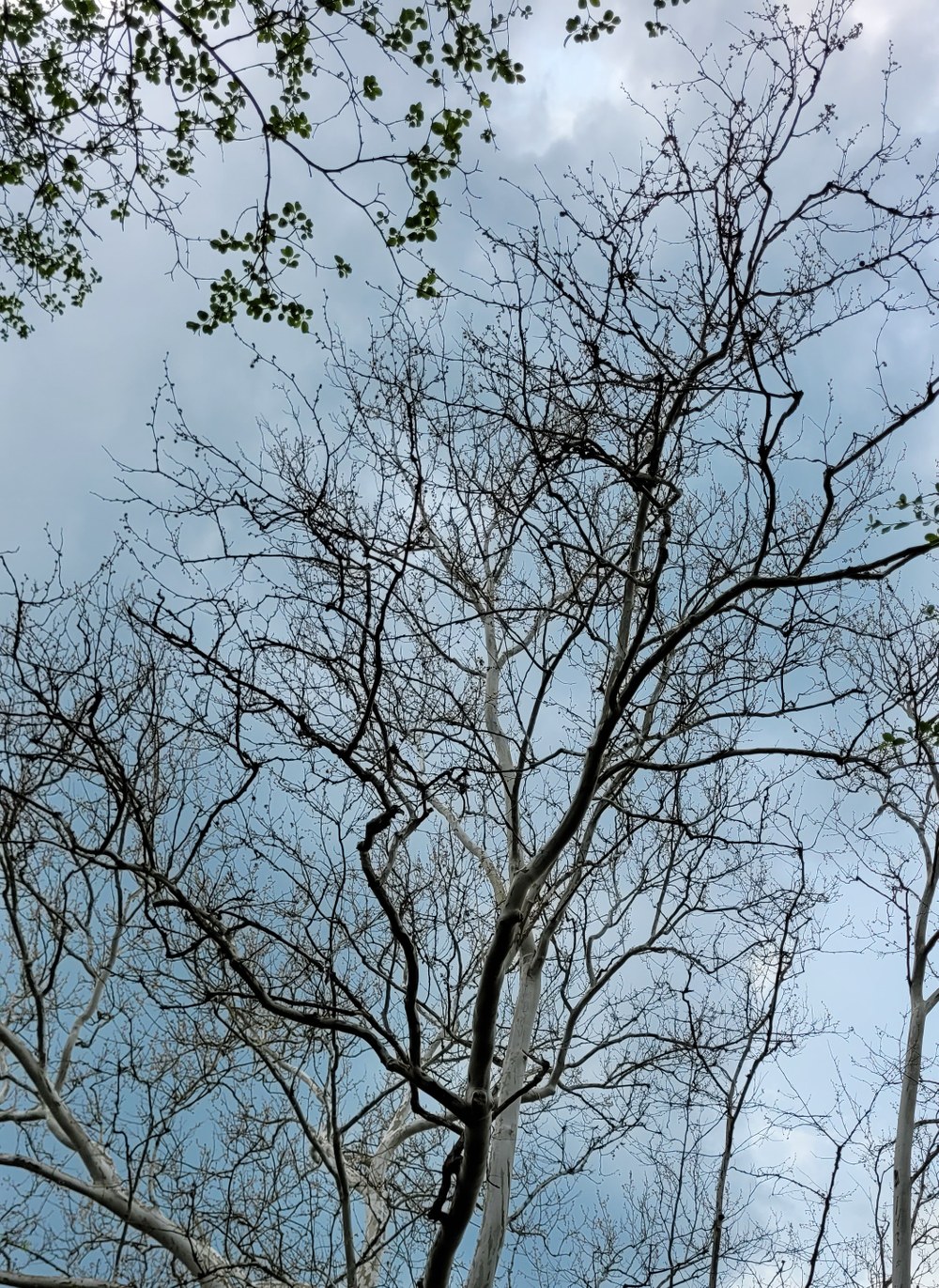Posted: May 31, 2023

A Sycamore has few developing leaves and initially seems like it could have been infected with anthracnose.
Written by Jeff Osborne, Forest Stewardship Program Associate, James C. Finley Center for Private Forests at Penn State
University Park, PA – May 30, 2023- Many of you may have noticed foliar damage to trees and shrubs within the past week. If you had below freezing temperatures, the cold could be the culprit, but there may also be damage from fungi, like anthracnose. Freeze damage and fungi damage will have different signs and symptoms. Once you identify the symptoms, you can understand the cause and understand what is in store for the plant’s future.
Many areas in PA near and north of I-80 had near and below freezing temperatures on May 18, 2023. Developing leaf and twig tissues in many species were damaged. In the damaged tissue, ice crystals formed inside cells, shredding and killing the cells. The leaves have now drooped or curled and turned brown or black. In the winter, there are two ways woody deciduous plants resist freezing in their cells: by having molecules, including sugars, within the cell fluid which lowers freezing temperature, and by migrating cellular fluid into space between cells. Some species have actively growing tissues which contain fluid that has a higher freezing temperature than others. In the growing season, when the systems are not prepared for below freezing temperatures, freeze damage quickly affects most or all of an individual plant, and freeze damage frequently affects multiple species in an area.


Staghorn sumac on the top and tulip poplar on the bottom a few days after below freezing temperatures. Taken on May 23,2023 just north of Scranton, PA.
Mid-May is also a time you start to notice twig death and leaf damage caused by various fungi, such as anthracnose. Cool, damp weather favors the fungi. Tree species affected generally host their own specific anthracnose fungi species. Anthracnose is often described as having three stages of infection. In one stage, the leaves are infected, and quickly turn brown to black along the leaf veins first, and then the rest of the leaf browns. Many of the leaves will fall by mid-summer and the tree will generally re-foliate in summer. The fungus can also kill branch tips and buds over winter. There will be cankers on the twigs and browning of interior twig tissue in this stage. Cankers on twigs can lead to multiple branches growing out of a single point, creating a bushy look to the ends of the limbs. Another stage kills the elongating twigs and emerging leaves quickly. The last two stages may be visually like early growing season frost damage. Anthracnose as the sole stressor of a tree generally will not kill the tree in one year, but can be a co-morbidity, meaning causing death when combined with another stressor, or kill a tree after several years of heavy infections. One species hit hard by anthracnose is sycamore. One of the first published descriptions of anthracnose symptoms exhibited by sycamore was in 1815 and based on widespread 1810 infections in trees planted in England. By 1925, the fungus was identified and described. Anthracnose affects sycamore in nearly all of it range, except its extreme northern and southern edges. Anthracnose is more severe in the northern part of its range, like here in PA(1). Sycamore can also be susceptible to frost damage. An early description and photo of frost damage on sycamore was published in the Missouri Botanical Garden’s 1907 annual report (2). In 1908, there was another author that referenced the Missouri Botanical Garden’s 1907 annual report and suggested that the sycamores in their area of New York were affected by frost but primarily affected by anthracnose since the symptoms in 1907 were the same symptoms exhibited by the trees in previous years where anthracnose was accepted as the culprit (3).


The Sycamore on the top has few developing leaves and initially seems like it could have been infected with anthracnose in the previous year and experienced significant twig death while dormant and shortly after bud break. More investigation of the twigs for cankers and discoloration is needed. The cluster of sycamores on the bottom, which are within 100 yards of the one on the left, are full of partially developed leaves which are almost all browning, but they don’t appear to be browning along the veins in a way described in anthracnose infections. Taken on May 23, 2023 just north of Scranton, PA.
The good news is most established and otherwise healthy trees will bounce back from damage from either source, although the fungi may take a larger toll with subsequent years of infections and weakened and bushy limbs from cankers. If you have a landscape tree you want to preserve, there are some steps you can take to reduce anthracnose’s effect. Removing dead leaves can reduce the amount of spores in the area. Reducing vegetation under the tree’s canopy can create dry conditions and reduce the vigor of anthracnose. Trees can also be treated with fungicide as a preventative measure.
References
1 Neely, Dan (1976, August) Sycamore Anthracnose. The Journal of Arboriculture, 153-157
2 von Schrenk, H. (1907). On Frost Injuries to Sycamore Buds. Missouri Botanical Garden Annual Report, 1907, 81–83. https://doi.org/10.2307/2400022
3 Stewart, F.C. (1908, January 23) Plant Diseases. The Country Gentleman, 82
James C. Finley Center for Private Forests
Address
416 Forest Resources BuildingUniversity Park, PA 16802
- Email PrivateForests@psu.edu
- Office 814-863-0401
- Fax 814-865-6275
James C. Finley Center for Private Forests
Address
416 Forest Resources BuildingUniversity Park, PA 16802
- Email PrivateForests@psu.edu
- Office 814-863-0401
- Fax 814-865-6275

